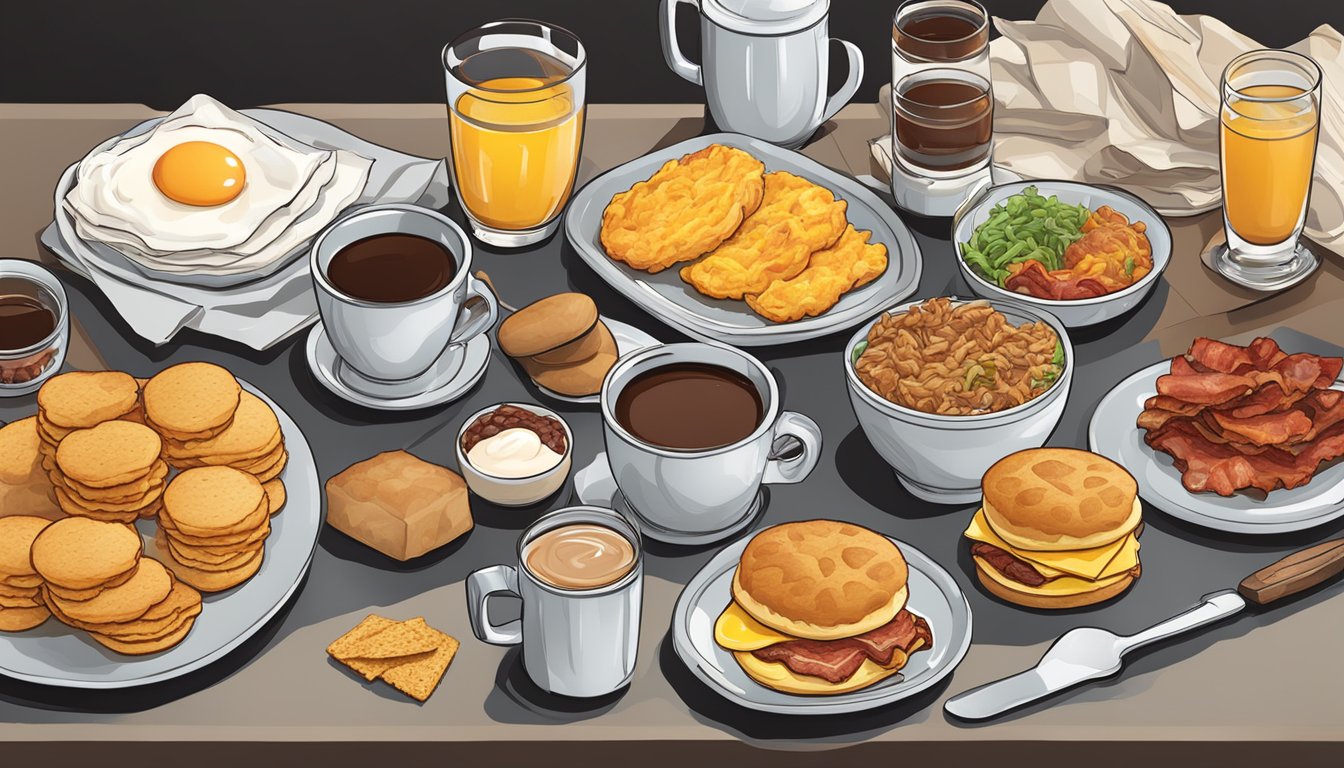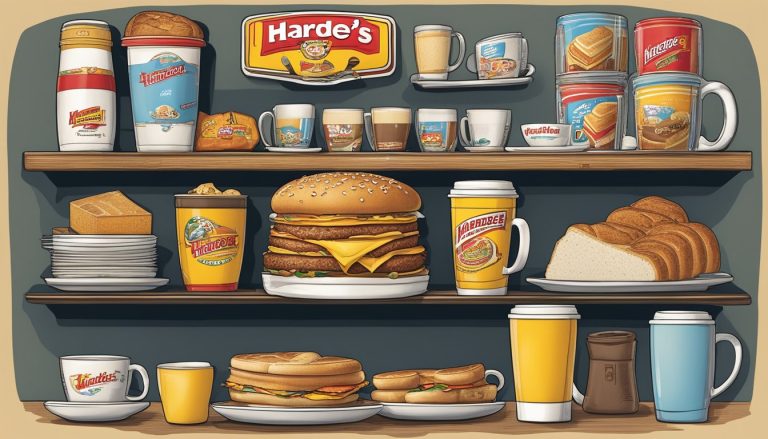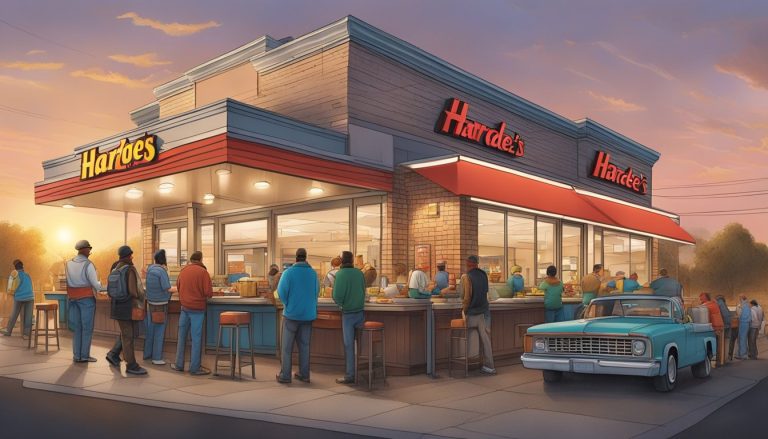Breakfast habits in America have undergone significant changes over the past century. In the early 1900s, a typical morning meal consisted of simple fare like rolls, fruit, and coffee. Today’s breakfast landscape is vastly different, with hearty options dominating many menus.
Hardee’s, a popular fast-food chain, offers a window into contemporary American breakfast culture. The restaurant’s menu reflects current preferences for protein-rich, calorie-dense morning meals, a stark contrast to the lighter fare of previous generations. This shift in eating habits provides sociologists with valuable insights into broader cultural trends and societal changes.
A closer examination of Hardee’s breakfast offerings and customer behaviors can reveal much about modern American lifestyles, values, and economic factors. From portion sizes to ingredient choices, each aspect of the Hardee’s breakfast experience offers clues about the evolving relationship between Americans and their first meal of the day.
Historical Context of Breakfast at Hardee’s
Hardee’s entered the fast-food scene in 1960 when Wilber Hardee opened the first restaurant in Greenville, North Carolina. The chain initially focused on hamburgers and quickly gained popularity.
In the early years, Hardee’s did not offer breakfast. The introduction of breakfast items came later as the company expanded and sought to compete with other fast-food chains.
By the 1970s and 1980s, Hardee’s had begun serving breakfast. This move aligned with changing American eating habits and the growing trend of grabbing quick breakfast on-the-go.
Hardee’s breakfast menu evolved over time, incorporating items like biscuits, breakfast sandwiches, and platters. These offerings appealed to customers seeking hearty, satisfying morning meals.
The chain’s breakfast became known for its made-from-scratch biscuits, setting it apart from competitors. This emphasis on freshly-prepared items resonated with consumers looking for quality in fast-food breakfast options.
In recent years, Hardee’s has adapted to changing dietary preferences. The introduction of Beyond Meat breakfast options in 2020 reflects the growing demand for plant-based alternatives in the fast-food industry.
Today, Hardee’s continues to serve breakfast across its more than 1,800 locations in the United States. The chain’s breakfast menu remains a significant part of its identity and appeal to customers.
Sociological Theories Applied to Fast Food Consumption

Functionalism views fast food as fulfilling a practical role in modern society. It provides quick, convenient meals for busy individuals and families.
Conflict theory examines power dynamics in the fast food industry. Large corporations profit while workers often receive low wages and limited benefits.
Symbolic interactionism focuses on the meanings people attach to fast food. For some, it represents a treat or reward. For others, it signifies unhealthy choices or American culture.
Social constructionism analyzes how societal norms shape perceptions of fast food. Marketing and media influence what foods are considered desirable or appropriate.
Dramaturgical theory examines fast food restaurants as stages where social performances occur. Customers and employees play defined roles with expected behaviors.
Network theory explores how social connections impact fast food consumption. Friends and family can influence eating habits and restaurant choices.
Rational choice theory suggests individuals weigh costs and benefits when deciding to eat fast food. Factors like price, convenience, and taste affect these calculations.
By applying these sociological perspectives, researchers gain deeper insights into the complex social factors driving fast food consumption in America.
Demographic Analysis of Hardee’s Breakfast Patrons

Hardee’s breakfast clientele represents a diverse cross-section of American society. The demographic breakdown reveals interesting patterns in age, economic status, and geographic distribution among those who frequent Hardee’s for their morning meals.
Age Distribution
Hardee’s breakfast patrons span multiple age groups, with a notable concentration in certain demographics. The core breakfast customer base falls between 25-54 years old, representing working adults and families.
Young adults aged 18-24 make up a significant portion, often college students or early career professionals seeking quick, affordable options. This group tends to visit more frequently during weekends.
Middle-aged adults between 35-54 form another key segment. They often choose Hardee’s for family breakfasts or as a convenient stop during their morning commute.
Seniors over 65 comprise a smaller but loyal group, appreciating the familiar menu and reasonable prices. They typically visit during off-peak hours, enjoying a more relaxed dining experience.
Economic Status
Hardee’s breakfast patrons predominantly come from middle to lower-middle income brackets. This aligns with the brand’s positioning as an affordable, hearty breakfast option.
Blue-collar workers form a substantial portion of the customer base. They value Hardee’s for its filling meals that fuel their physically demanding jobs.
Lower-income families also frequent Hardee’s, attracted by the combination of portion sizes and value pricing. The menu offers options that can feed multiple family members affordably.
College students and young professionals on a budget make up another significant segment. They appreciate the balance of taste, convenience, and cost-effectiveness.
A smaller segment includes middle-income professionals who choose Hardee’s for its convenience and familiar menu offerings during busy mornings.
Geographical Variations
Hardee’s breakfast patronage shows distinct regional patterns, reflecting the brand’s historical roots and expansion strategy.
Southern United States:
- Highest concentration of loyal customers
- Strong brand recognition and cultural resonance
- Popular among rural and suburban communities
Midwest:
- Growing customer base
- Appeals to traditional values and hearty appetites
- Competes well against local diners and other fast-food chains
Northeast and West Coast:
- Lower market penetration
- Attracts customers seeking alternatives to local chains
- Popular among transplants from Hardee’s stronghold regions
Urban areas see a mix of blue-collar workers and young professionals as primary breakfast patrons. Suburban locations attract more families and commuters. Rural Hardee’s often serve as community gathering spots, especially for morning crowds.
Menu Analysis: Popular Items and Nutritional Content

Hardee’s breakfast menu features a variety of popular items that cater to American tastes. The Hardee Breakfast Platter stands out as a substantial offering, available with bacon, ham, or sausage.
This hearty meal includes a biscuit, gravy, folded eggs, and Hash Rounds. The platter’s calorie content ranges from 860 to 1050, depending on the chosen meat option.
For those seeking a handheld option, the Bacon, Egg and Cheese Biscuit is a popular choice at 530 calories. The Chicken Fillet Biscuit provides another protein-rich alternative at 500 calories.
Hardee’s also offers lighter fare. The Hash Rounds in a small serving contain 260 calories, with 140 calories from fat. This side dish provides a crispy texture to complement other breakfast items.
Nutritional information reveals that many breakfast options are high in sodium and saturated fat. The Hardee Breakfast Platter contains between 2210 and 2310 mg of sodium, a significant portion of the recommended daily intake.
Protein content varies across menu items. The breakfast platters offer between 28 to 31 grams of protein, supporting the perception of a “filling” meal that many Americans seek in their morning fare.
Cultural Significance of Fast Food Breakfasts
Fast food breakfasts have become deeply ingrained in American culture, reflecting shifts in societal norms and eating habits. These quick morning meals represent a move away from traditional home-cooked breakfasts towards convenience-oriented options.
The rise of fast food breakfast menus has redefined morning routines for many Americans. It caters to busy lifestyles, allowing people to grab a meal on-the-go while commuting or heading to work.
Fast food breakfast offerings often blend familiar comfort foods with portability. Items like breakfast sandwiches and burritos combine traditional breakfast ingredients in easy-to-eat formats.
The popularity of these meals has influenced portion sizes and calorie expectations. “Super-sizing” trends that began in fast food have normalized larger portions across American dining culture.
Fast food breakfasts also reflect changing family dynamics. As more households have two working parents, quick morning meals have become a practical solution for time-pressed families.
These breakfast options have become cultural touchstones, with certain menu items achieving iconic status. They often evoke nostalgia and represent shared experiences across diverse demographics.
The prevalence of fast food breakfasts has sparked debates about nutrition and public health. This has led to menu innovations, with many chains now offering healthier alternatives alongside traditional options.
Impact of Hardee’s Marketing Strategies

Hardee’s marketing strategies have significantly influenced American eating habits and consumer behavior in the fast-food industry. The company’s approach focuses on targeted advertising, audience segmentation, and brand loyalty initiatives.
Advertising Campaigns
Hardee’s advertising campaigns often feature indulgent, oversized burgers and hearty breakfast items. These ads emphasize taste and portion size, appealing to consumers seeking satisfying meals. The company’s “Eat Like You Mean It” slogan reinforces this message.
Television commercials frequently showcase close-up shots of sizzling meat and melting cheese. This visual technique aims to trigger cravings and impulse purchases.
Social media plays a crucial role in Hardee’s marketing strategy. The brand leverages platforms like Instagram and Twitter to engage younger audiences and promote limited-time offers.
Target Audiences
Hardee’s primarily targets young adult males aged 18-34. This demographic is known for higher fast-food consumption rates and a preference for larger portion sizes.
The brand also appeals to blue-collar workers and rural communities. Menu items like biscuits and gravy cater to traditional American breakfast preferences in these regions.
In recent years, Hardee’s has expanded its focus to include health-conscious consumers. The introduction of lower-calorie options and salads aims to broaden the customer base.
Branding and Consumer Loyalty
Hardee’s branding emphasizes quality ingredients and made-from-scratch menu items. This approach differentiates the chain from competitors and fosters consumer trust.
The company’s loyalty program, “Stars for Rewards,” incentivizes repeat visits. Customers earn points for purchases, redeemable for free menu items.
Seasonal promotions and limited-time offers create a sense of urgency and excitement. These strategies encourage frequent visits and menu exploration.
Hardee’s partnership with NASCAR has strengthened brand loyalty in key markets. Sponsorships and themed menu items resonate with racing fans and reinforce the brand’s all-American image.
Behavioral Patterns of Hardee’s Morning Customers

Hardee’s breakfast patrons exhibit distinct behavioral patterns that offer insights into American eating habits. Early risers, typically working professionals and students, arrive between 6-8 AM seeking quick, hearty meals before their day begins.
Many customers display a preference for familiar menu items, repeatedly ordering the same dishes. This behavior suggests comfort in routine and a desire for consistency in their morning ritual.
Drive-thru traffic peaks around 7:30 AM, with customers often multitasking – eating while commuting or reviewing work materials. This reflects the fast-paced nature of modern American life and the prioritization of efficiency.
In-store diners tend to fall into two categories:
- Solo eaters focused on their phones or newspapers
- Small groups engaged in casual conversation
These patterns highlight the dual role of breakfast as both a solitary fuel-up and a social activity.
Menu choices often align with generational preferences:
- Younger customers gravitate towards innovative items like breakfast bowls
- Older patrons stick to traditional offerings such as biscuits and gravy
This divide reflects broader societal trends in food preferences and health consciousness.
Observation shows that many customers value portion size, often selecting larger combo meals. This aligns with the American cultural emphasis on perceived value in food purchasing decisions.
Time-Saving Convenience or Lifestyle Choice?

Hardee’s breakfast menu caters to the fast-paced American lifestyle. The chain recognizes the value of time in today’s society, offering quick service through dine-in, takeout, and drive-thru options.
For many, choosing fast food breakfast is a matter of convenience. Busy professionals and families often prioritize speed and efficiency in their morning routines.
However, the popularity of Hardee’s breakfast goes beyond mere time-saving. It has become a cultural phenomenon, reflecting broader shifts in American eating habits.
Some consumers view fast food breakfast as a treat or indulgence. They may opt for Hardee’s even when time is not a constraint, suggesting it has evolved into a lifestyle choice.
The chain’s extensive menu appeals to various tastes and dietary preferences. This diversity allows customers to align their fast food choices with personal values and health goals.
Hardee’s breakfast hours, starting as early as 4:00 or 5:00 AM in some locations, accommodate diverse work schedules and lifestyles. This flexibility further blurs the line between necessity and preference.
Ultimately, the choice to eat Hardee’s breakfast represents a complex interplay of factors. These include time constraints, taste preferences, cultural norms, and individual lifestyle decisions.
Health Implications of a Fast Food Breakfast
Fast food breakfasts can have significant health consequences when consumed regularly. These meals often contain high levels of saturated fats, which are linked to increased risk of cardiovascular disease.
Many breakfast items at chains like Hardee’s feature sausage and bacon, which are high in saturated fat and sodium. Excessive sodium intake is associated with hypertension and other cardiovascular issues.
The calorie content of fast food breakfasts tends to be high. Consuming excess calories regularly contributes to weight gain and obesity over time. Obesity is a risk factor for numerous health conditions, including diabetes and certain cancers.
Fast food breakfasts frequently lack adequate fiber and nutrients. This nutritional imbalance may lead to digestive issues and leave consumers feeling hungry again soon after eating.
Sugar content is another concern. Sweetened breakfast drinks and pastries can cause rapid blood sugar spikes followed by crashes, potentially contributing to insulin resistance over time.
Regular consumption of fast food breakfasts has been associated with poorer overall diet quality. This can lead to nutrient deficiencies and increased risk of chronic diseases.
Eating fast food breakfasts may also contribute to unhealthy eating patterns throughout the day. Studies suggest that starting the day with nutrient-poor choices can influence subsequent food decisions negatively.
Comparative Study: Hardee’s Vs. Other Fast Food Chains

Hardee’s stands out among fast food chains for its unique offerings and approach to the breakfast market. This comparative analysis examines how Hardee’s measures up to its competitors in key areas.
Menu Diversity
Hardee’s breakfast menu boasts an impressive array of options, particularly in biscuit sandwiches. The chain offers 10 different biscuit sandwich varieties, surpassing many competitors in this category.
Carl’s Jr., despite being under the same parent company, has a more limited breakfast selection with only three biscuit sandwiches. This disparity highlights Hardee’s focus on the morning meal segment.
Compared to industry giant McDonald’s, Hardee’s maintains a competitive edge in menu diversity. While McDonald’s is known for its Egg McMuffin, Hardee’s provides a wider range of breakfast proteins and preparations.
Price Points
Hardee’s pricing strategy positions it in the mid-range of fast food breakfast options. Their menu items are generally more affordable than upscale fast-casual chains like Shake Shack.
A standard Hardee’s breakfast sandwich typically costs less than Shake Shack’s offerings. This price difference reflects the chains’ distinct market positioning and ingredient sourcing practices.
However, Hardee’s prices are often slightly higher than those of McDonald’s or Burger King. This pricing strategy aligns with Hardee’s emphasis on larger portion sizes and perceived higher quality ingredients.
Customer Satisfaction
Hardee’s has cultivated a loyal customer base, particularly in regions where it has a strong historical presence. The chain’s focus on hearty, indulgent breakfast options appeals to customers seeking substantial morning meals.
Customer reviews often praise Hardee’s for its made-from-scratch biscuits and generous portion sizes. These factors contribute to higher satisfaction rates compared to some competitors.
However, Hardee’s faces stiff competition in customer satisfaction from chains like Chick-fil-A, which consistently ranks high in national surveys. Hardee’s continues to innovate and improve its offerings to maintain customer loyalty in a competitive market.
Economic Impact of Fast Food on Local Communities

Fast food restaurants have become integral parts of many local economies across America. These establishments contribute to job creation, offering employment opportunities for various skill levels.
Entry-level positions provide valuable work experience for young people entering the job market. Management roles offer career advancement possibilities within the industry.
Fast food chains often stimulate local business ecosystems. They frequently partner with local suppliers for ingredients and services, creating a ripple effect in the community’s economy.
The presence of fast food restaurants can increase foot traffic in commercial areas. This can benefit neighboring businesses by attracting more potential customers to the vicinity.
However, the economic impact isn’t always positive. Local, independent restaurants may struggle to compete with the efficiency and low prices of large fast food chains.
Fast food establishments can also affect property values. While they may increase commercial property values, some studies suggest they could potentially decrease residential property values in close proximity.
Tax revenue is another consideration. Fast food restaurants contribute to local tax bases through sales tax, property tax, and other business-related taxes.
The industry’s impact on healthcare costs is a complex issue. While fast food provides affordable meals, concerns about nutrition and long-term health effects may indirectly influence community healthcare expenditures.
In summary, fast food restaurants play a multifaceted role in local economies, offering both opportunities and challenges for communities to navigate.
Potential for Future Changes in Eating Habits

American eating habits are poised for significant shifts in the coming years. Fast food chains like Hardee’s may need to adapt their breakfast offerings to align with emerging trends.
Health consciousness is likely to play a larger role in food choices. Consumers are becoming more aware of the nutritional content and origins of their meals.
Plant-based options are gaining popularity. Fast food restaurants may expand their menus to include more vegetarian and vegan items, even for breakfast.
Convenience will remain important, but with a focus on quality. Grab-and-go options that are both nutritious and tasty could see increased demand.
Technology may reshape how people order and receive their food. Mobile apps, delivery services, and automated ordering systems could become more prevalent.
Customization is expected to grow in importance. Restaurants may offer more mix-and-match options, allowing customers to personalize their breakfast meals.
Local and sustainable sourcing may influence consumer choices. Fast food chains might highlight locally sourced ingredients to appeal to environmentally conscious customers.
Portion sizes could see changes. There may be a trend towards smaller, more frequent meals throughout the day, affecting traditional breakfast norms.




